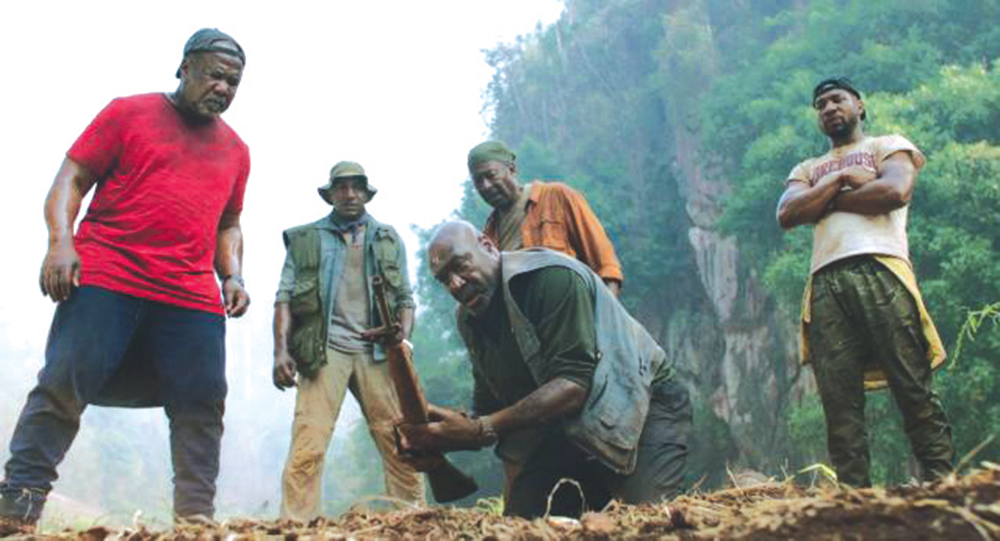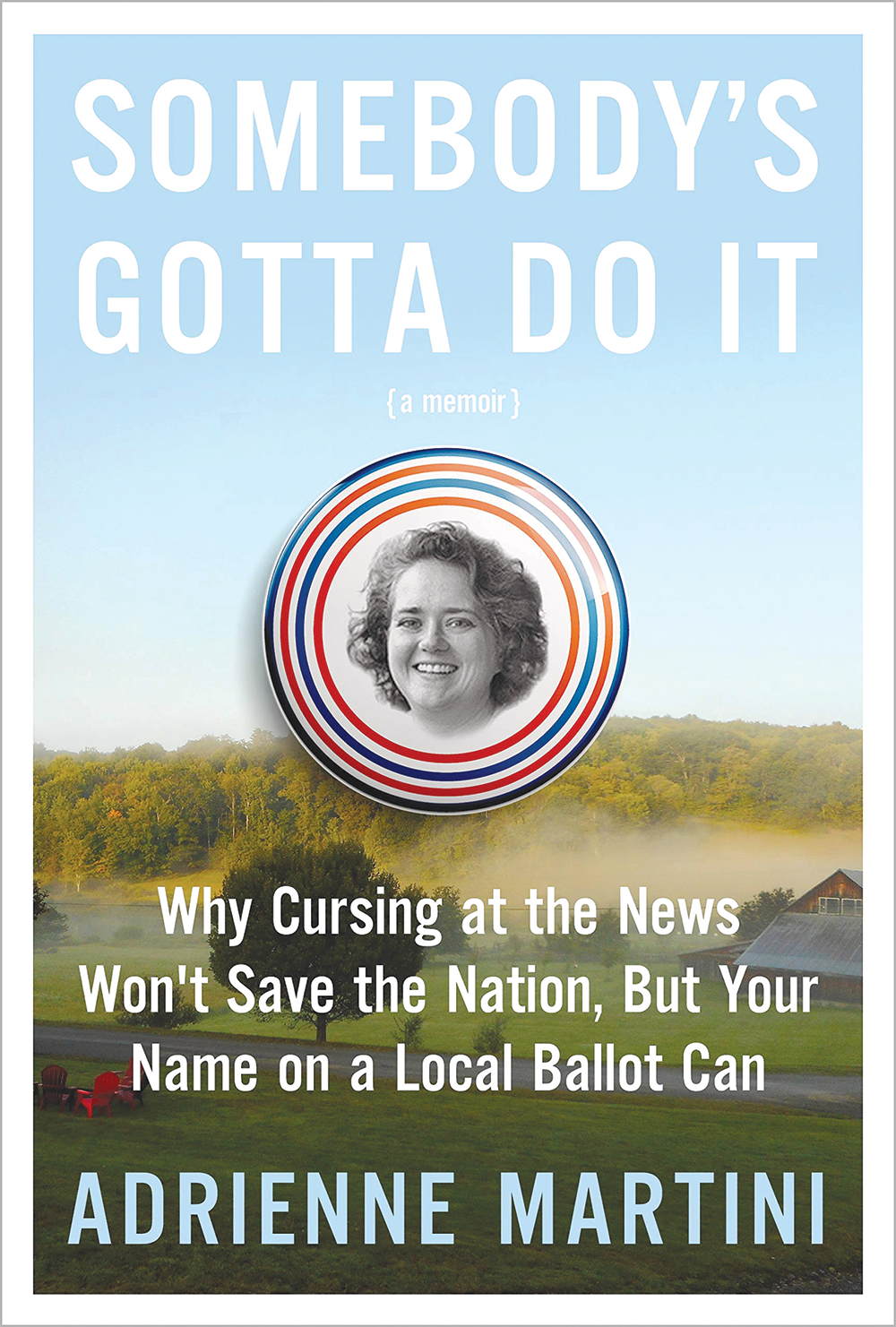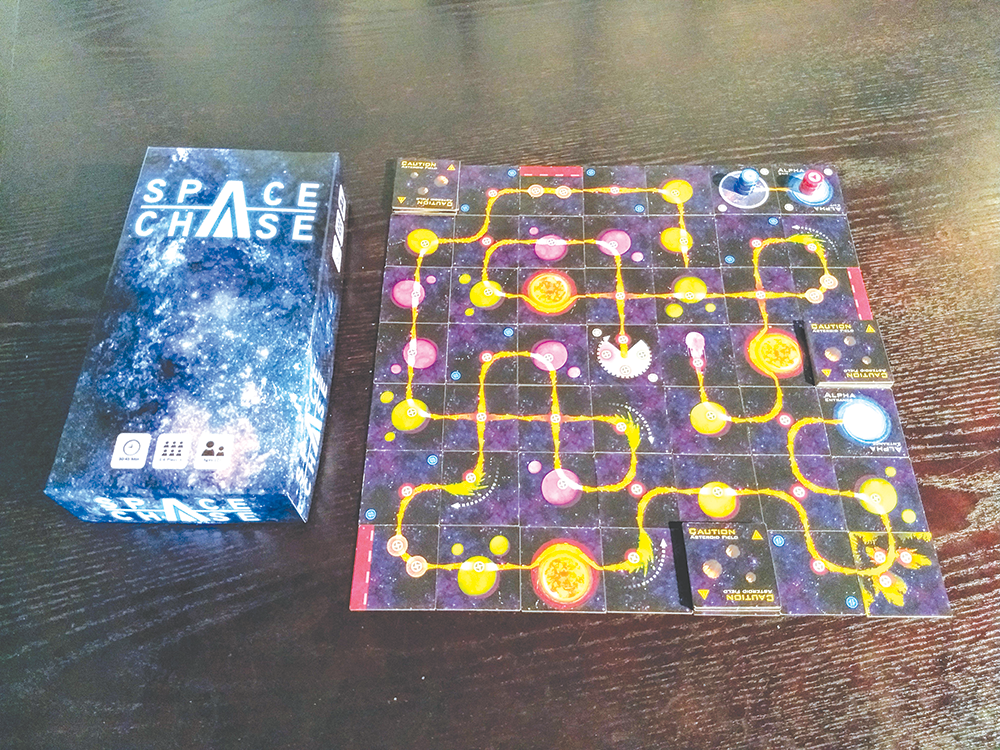Da 5 Bloods (R)
Spike Lee blends a Vietnam war movie with a quest-for-treasure movie with Da 5 Bloods, a new Netflix release.
Former Army squad-mates Paul (Delroy Lindo), Otis (Clarke Peters), Eddie (Norm Lewis) and Melvin (Isiah Whitlock Jr.) arrive in 21st-century Vietnam to retrieve the body of their squad leader, Norman (Chadwick Boseman), who died during the war. They have also returned in search of gold. As we see in flashbacks to the war, they were sent to retrieve a case of gold bars (CIA money meant to pay local allies) from a plane that crashed in the jungle. After an ambush left only these five men alive, Norman, who had held the squad together through their anguish over the assassination of the Rev. Dr. Martin Luther King Jr. and the ongoing inequality faced by African American troops, argued that they should keep the gold for themselves and their community.
Now a mudslide has revealed a bit of the plane, which, along with the burial site for Norman and the gold, had been lost in the fog of war. But even before the men find the gold, they are weighed down by the past. Paul seems to be the man most aggressively suffering from post-traumatic stress, which has spilled over into his relationship with his adult son David (Jonathan Majors), who shows up, uninvited, on the trip. Otis reaches out to an old girlfriend (Lê Y Lan) and learns that their relationship was more complicated than he knew. The ghosts of the past haunt all of the men, with greater intensity as they set out to hike to the crash site.
I reread my review of Miracle at St. Anna, Lee’s 2008 World War II film, and my feelings about that movie are very similar to my reaction to Da 5 Bloods. This movie, like that one, plays with Hollywood war movie conventions, is packed full of rich moments, pulls in fascinating elements of history, has very Spike Lee visual arrangements, has a very Spike Lee movie score (by Terence Blanchard, who has scored most of Lee’s movies) and has character beats that make you want to know more. It’s a lot for one movie and it doesn’t all always come together. Even though this movie is two hours and 35 minutes, it felt like it needed more time to develop all of the elements it throws into the mix (or needed to edit out a few that didn’t get as much development).
Da 5 Bloods is actually the first of these cinema-at-home movies that I wished I had seen in a theater. I feel like the bigness of what Lee is doing would have worked better on a big screen. At times, the “in search of gold” half of the movie feels like it is fighting with the “fuller look at history” half with its sharp commentary on African American military history and the wider context of racism and injustice in American society. There are a lot of moving parts here (including a whole subplot about a French woman and a landmine clearing nonprofit that I feel like is thematically relevant but a drag on the narrative) but there are also strong performances (from Lindo in particular) and eloquently delivered Spike Lee statements that stick with you.
Here’s how I’m going to recommend Da 5 Bloods — and I do recommend this movie, especially to movie nerds and Spike Lee fans: Make your viewing experience as cinema-like as you can. Dim the lights, put away the phone and watch it all the way through. B
“Rated R for strong violence, grisly images and pervasive language,” according to the MPA on filmratings.com. Directed by Spike Lee and written by Danny Bilson & Paul De Meo and Kevin Willmott & Spike Lee, Da 5 Bloods is two hours and 35 minutes long and available on Netflix.
Shirley (R)
A young couple comes to live with author Shirley Jackson and her husband in Shirley, a not-quite biopic based on a novel by Susan Scarf Merrell.
The movie seems set in the late 1940s and early 1950s at the still all-women Bennington College in Vermont. Rose (Odessa Young) and Fred (Logan Lerman) are a newly married couple who come to Bennington so Fred can work as an assistant for professor Stanley Hyman (Michael Stuhlbarg), husband of famous but reclusive writer Shirley Jackson (Elisabeth Moss).
Stuhlbarg really goes the extra mile to make Stanley unlikeable. I have no idea what real-life Stanley Hyman was like but here he is a blowhard who has affairs and makes little speeches about the horrors of mediocrity when he himself seems pretty mediocre, particularly in comparison to his wife. The picture of Shirley here is a woman suffering from mental illness but also from some degree of gaslighting by her husband, who seems to exaggerate her difficulties and seems to have her convinced that she desperately needs him.
Rose and Fred, shakily on their own after an elopement that Fred’s family frowned on and expecting a baby, are no match for this couple and their drama. Fred seems to quickly give in to the temptations of Bennington while Rose is saddled with becoming the designated housewife for both families — cooking and cleaning for Stanley and Shirley as well as her husband. Shirley, who is mulling over a novel based on the disappearance of a local girl, is sick, Stanley tells Rose, but also we suspect that Stanley is clearing the decks so Shirley can write — the movie (and Wikipedia) leaves us with the impression that not only is Shirley’s fame greater than Stanley’s but so is her paycheck.
Moss’s Shirley is fascinating. She crafts a character who is clearly suffering but isn’t a victim. She seems to resent Stanley, love him deeply, need him and see him for his flaws, all at the same time. She is, as with other recent Moss characters (in The Invisible Man and Her Smell for example), full of big emotions but Moss is able to convey those big emotions and big moments and even elements of madness (another thing Moss excels at) without tipping into cartoonishness.
Shirley feels like she’s running twice as fast as Shirley. About halfway through the movie, I realized I was still waiting for it to start. As Shirley pulls Rose in — to the source-material story of the missing girl, to Shirley’s creative process, to Shirley herself — we see Rose getting lost in all of it. It’s interesting, but it’s all slow to develop and it’s almost as if the movie is so focused on everything Moss is doing that it has to remind itself to pay attention to Rose.
As not-quite-tight as the movie overall is, it’s worth a look, especially for Moss’s performance. B
“Rated R for sexual content, nudity, language and brief disturbing images,” according to the MPA on filmratings.com. Directed by Josephine Decker with a screenplay by Sarah Gubbins (from a novel by the same name from Susan Scarf Merrell), Shirley is an hour and 47 minutes long and distributed by Neon. It’s available for rent or purchase.
The King of Staten Island (R)
Pete Davidson plays a young man adrift and suffering in The King of Staten Island, a somewhat-autobiographical (about Davidson) movie directed by Judd Apatow.
The “Apatow” part of that sentence might have you thinking this movie is a comedy, even if you know about Davidson’s mental health struggles and his family history (his firefighter father died at the World Trade Center site on Sept. 11). It would be more accurate to say that there are funny moments in this drama.
Stuck in his life, Scott (Davidson), age 24, dabbles in self-destructive behavior (shutting his eyes while driving on the highway) and in tattooing and is generally aimless, hanging out with his buddies, unwilling to take his relationship with Kelsey (Bel Powley) seriously and half-heartedly working a part-time job while still living with his mom, Margie (Marisa Tomei), even as his younger sister (Maude Apatow) heads to college.
As the movie tells us early on, Scott hasn’t really been able to move forward after the loss of his firefighter father (who died fighting a fire when Scott was a kid). Just how much becomes clear when Margie starts dating Ray (Bill Burr), also a firefighter and the first serious relationship she’s had since her husband died. Ray’s presence spurs her to nudge Scott to think about moving out, which sends him into a tailspin of anxiety.
I feel like both Davidson and Apatow have a very solid and complete idea of who this character is and what his struggles are — not surprising since everything I’ve read and seen about this movie (including videos on the movie’s official website) so heavily underlines how much of Pete is in Scott. And Davidson plays this character version of himself with genuine, to-the-bone emotion — he brought similar layers to a performance in Big Time Adolescence, a movie released on Hulu earlier this year, and here brings even more vulnerability.
But I didn’t get the sense that this movie always knew what to do with this character. At about the 50-minute point I felt like this movie was spinning its wheels still setting up who Scott is. The movie is also uneven in how it uses a subplot involving Scott’s friends, and Scott and Ray’s relationship seems to take an unnecessary amount of time to get to where it’s pretty clear that it’s going. Everything in the middle of this movie — from the initial 30 or so minutes and until it hits its final 30 to 40 minutes — seems to suffer from a lack of a heartless editor, someone who could slice out all the moments that are probably viewed fondly by Davidson (and maybe also Apatow, whose movies seem to have become progressively looser and filled with scenes that probably should have remained outtakes) but get in the way of both Scott’s arc and where the movie heads in its final act.
It’s hard to completely discount a movie as deeply felt as The King of Staten Island clearly is and with such a clear and specific character at its core. And I didn’t hate it. But I did wish I didn’t have to slog through all the messy extra bits.B-
“Rated R for language and drug use throughout, sexual content and some bloody violence/bloody images,” according to the MPA on filmratings.com.






